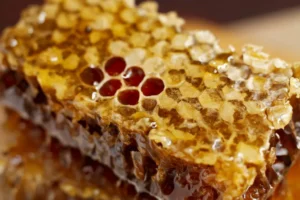Beeswax is one of the most valuable gifts that nature has given us through the tireless work of bees. It is a natural, biologically active substance that has been used for thousands of years for healing, health maintenance and beautification. Wax is a product of the glands of honey bees, which is mainly used to build combs in the hive.
It is distinguished by a dense but flexible texture, a characteristic warm aroma with nuances of honey, propolis and pollen, and a color ranging from light yellow to golden or brownish. Real, unrefined beeswax is not only natural, but also completely biodegradable, making it suitable for a wide range of environmentally friendly applications.
How Beeswax is Formed
The production of beeswax is a complex and amazing process. Bees begin to secrete it when they reach the age of about 12 to 18 days. Wax is secreted in the form of small flakes from special wax glands located in the lower part of the bee’s abdomen. In order to produce it, bees must consume a large amount of nectar and honey – about 8 kilograms of honey are needed to produce one kilogram of wax!
Once separated, the wax is softened and shaped with the help of the bees’ jaws and legs. This is how the wax cells are built, which serve as a home, storage and birthing place for the bee colony.
An interesting fact is that bees begin to produce more wax during periods of active construction in the hive – in spring and early summer. Wax is not only a building material, but also a natural preservative, protecting honey and pollen from external influences.
Healing properties of beeswax
Beeswax treatment is a practice with deep roots in folk medicine. This is no coincidence – the chemical composition of wax makes it extremely valuable for health. Beeswax contains over 300 compounds, including fatty acids, alcohols, hydrocarbons and esters, as well as vitamin A, which helps restore and improve skin elasticity. Its anti-inflammatory and antibacterial components help promote natural tissue healing.
Main healing properties:
- Antiseptic – protects against infections;
- Anti-inflammatory – reduces redness and pain;
- Softening and nourishing – especially useful for dry, sensitive or cracked skin;
- Healing – accelerates regeneration in wounds, burns and irritations.
Beeswax does not irritate the skin and is suitable even for people with sensitive dermis, as long as they are not allergic to bee products. It creates a protective barrier that retains moisture in the skin and protects it from external aggressors, while allowing the skin to “breathe”.
Applications in various fields
Thanks to its qualities, beeswax is widely used not only in medicine and cosmetics, but also in other areas of life:
In natural medicine
For joint and muscle pain – wax applications with warm beeswax relieve rheumatic pain, arthritis and muscle tension;
Respiratory problems – chewing a piece of beeswax helps with coughs, sinusitis and sore throats;
Skin problems – used in ointments for eczema, psoriasis, cracks and wounds.
In cosmetics
Base for natural creams, balms and masks;
Ingredient in handmade soaps;
Lip balms and body oils that hydrate and nourish the skin.
In aromatherapy and wellness practices
For making wax candles that burn cleanly and emit a light, honey aroma, creating coziness and peace;
Massages with wax mixtures – for a relaxing effect on the nervous system.
In the food industry
Wax is used to coat cheeses and fruits, protecting them from spoilage in a completely natural way. And chewing honey from beeswax is popular not only as a treatment, but also as a tasty and healthy habit.
How to use beeswax at home
One of the most valuable qualities of beeswax is that it is easy to use at home. With a little effort and quite affordable ingredients, you can prepare effective natural products for health and body care.
Homemade healing ointment for skin irritations
Ingredients:
2 tbsp. beeswax (grated or granulated), 4 tbsp. olive oil or calendula oil, 1 tsp. honey, lavender or tea tree essential oil (optional)
Preparation method:
Melt the wax and oil in a water bath, add the honey and mix. When the mixture has cooled slightly, add a few drops of essential oil. Pour into a small jar. Use on dry skin, cuts, eczema, or insect bites.
Wax Lip Balm
Ingredients:
One teaspoon each of beeswax, shea butter, and coconut oil
A few drops of vanilla extract or peppermint
Melt the ingredients together and pour into a small container. The balm will hydrate your lips and protect them from chapping during the cold months.
Wax applications for pain
Melt wax and pour it onto a linen cloth. When it cools to a tolerable temperature, place the compress on the painful area. It is especially effective for back, joint or waist pain.
Chewing a piece of beeswax
Freshly taken from the hive, beeswax filled with honey can be chewed for 5–10 minutes a day. This strengthens the gums, freshens breath and has a beneficial effect on colds.
In a world where we are increasingly looking for purity, simplicity and a return to our roots, beeswax reminds us of the power of nature. It is not just a means of treatment – it is a symbol of the connection between man and nature, an expression of harmony, tenderness and care.
Treatment with beeswax is proof that complex medications and chemical formulas are not always needed to feel good. Sometimes the solution lies in the simplest things – in what bees create with patience and love. Let us use it with gratitude and respect.
